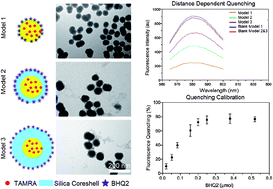Our official English website, www.x-mol.net, welcomes your feedback! (Note: you will need to create a separate account there.)
Enhanced distance-dependent fluorescence quenching using size tuneable core shell silica nanoparticles†
RSC Advances ( IF 3.9 ) Pub Date : 2018-10-19 00:00:00 , DOI: 10.1039/c8ra05929b Mohamed M Elsutohy 1, 2 , Amjad Selo 1 , Veeren M Chauhan 1 , Saul J B Tendler 1, 3 , Jonathan W Aylott 1
RSC Advances ( IF 3.9 ) Pub Date : 2018-10-19 00:00:00 , DOI: 10.1039/c8ra05929b Mohamed M Elsutohy 1, 2 , Amjad Selo 1 , Veeren M Chauhan 1 , Saul J B Tendler 1, 3 , Jonathan W Aylott 1
Affiliation

|
Silica nanoparticles (SNPs) have been used as favoured platforms for sensor, drug delivery and biological imaging applications, due to their ease of synthesis, size-control and bespoke physico-chemical properties. In this study, we have developed a protocol for the synthesis of size-tuneable SNPs, with diameters ranging from 20 nm to 500 nm, through the optimisation of experimental components required for nanoparticle synthesis. This protocol was also used to prepare fluorescent SNPs, via covalent linkages of fluorophores, to the nanoparticle matrix using 3-aminopropyltriethoxysilane (APTES). This enabled the fabrication of ratiometric, fluorescent, pH-sensitive nanosensors (75 nm diameter) composed SNPs covalently linked to two pH-sensitive fluorescent dyes Oregon Green (OG) and 5(6)-carboxyfluorescein (FAM) and a reference fluorescent dye 5-(6)-carboxytetramethylrhodamine (TAMRA), extending the dynamic range of measurement from pH 3.5 to 7.5. In addition, size-tuneable, core–shell SNPs, covalently linked to a fluorescent TAMRA core were synthesised to investigate distance-dependant fluorescence quenching between TAMRA and black hole quencher 2 (BHQ2®) using nanometre-sized silica shells as physical spacers. The results showed a significant fluorescence quenching could be observed over greater distances than that reported for the classical distance-dependent molecular fluorescence quenching techniques, e.g. the Förster (fluorescence) resonance energy transfer (FRET). The methods and protocols we have detailed in this manuscript will provide the basis for the reproducible production of size tunable SNPs, which will find broad utility in the development of sensors for biological applications.
中文翻译:

使用尺寸可调的核壳二氧化硅纳米粒子增强距离依赖性荧光猝灭†
由于易于合成、尺寸控制和定制的物理化学特性,二氧化硅纳米粒子 (SNP) 已被用作传感器、药物输送和生物成像应用的首选平台。在这项研究中,我们通过优化纳米粒子合成所需的实验组件,开发了一种用于合成尺寸可调 SNP 的协议,直径范围从 20 nm 到 500 nm。该协议还用于制备荧光 SNP,通过使用 3-氨基丙基三乙氧基硅烷 (APTES) 将荧光团共价连接到纳米颗粒基质。这使得能够制造比例、荧光、pH 敏感纳米传感器(直径 75 nm)由 SNP 共价连接到两种 pH 敏感荧光染料俄勒冈绿 (OG) 和 5(6)-羧基荧光素 (FAM) 和参考荧光染料 5 -(6)-羧基四甲基罗丹明 (TAMRA),将动态测量范围从 pH 3.5 扩展到 7.5。此外,合成了与荧光 TAMRA 核共价连接的尺寸可调的核壳 SNP,以使用纳米尺寸的二氧化硅壳作为物理间隔物研究 TAMRA 和黑洞猝灭剂 2 (BHQ2®) 之间的距离依赖性荧光猝灭。例如Förster(荧光)共振能量转移(FRET)。我们在本手稿中详述的方法和协议将为尺寸可调 SNP 的可重复生产提供基础,这将在生物应用传感器的开发中找到广泛的用途。
更新日期:2018-10-19
中文翻译:

使用尺寸可调的核壳二氧化硅纳米粒子增强距离依赖性荧光猝灭†
由于易于合成、尺寸控制和定制的物理化学特性,二氧化硅纳米粒子 (SNP) 已被用作传感器、药物输送和生物成像应用的首选平台。在这项研究中,我们通过优化纳米粒子合成所需的实验组件,开发了一种用于合成尺寸可调 SNP 的协议,直径范围从 20 nm 到 500 nm。该协议还用于制备荧光 SNP,通过使用 3-氨基丙基三乙氧基硅烷 (APTES) 将荧光团共价连接到纳米颗粒基质。这使得能够制造比例、荧光、pH 敏感纳米传感器(直径 75 nm)由 SNP 共价连接到两种 pH 敏感荧光染料俄勒冈绿 (OG) 和 5(6)-羧基荧光素 (FAM) 和参考荧光染料 5 -(6)-羧基四甲基罗丹明 (TAMRA),将动态测量范围从 pH 3.5 扩展到 7.5。此外,合成了与荧光 TAMRA 核共价连接的尺寸可调的核壳 SNP,以使用纳米尺寸的二氧化硅壳作为物理间隔物研究 TAMRA 和黑洞猝灭剂 2 (BHQ2®) 之间的距离依赖性荧光猝灭。例如Förster(荧光)共振能量转移(FRET)。我们在本手稿中详述的方法和协议将为尺寸可调 SNP 的可重复生产提供基础,这将在生物应用传感器的开发中找到广泛的用途。


























 京公网安备 11010802027423号
京公网安备 11010802027423号